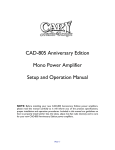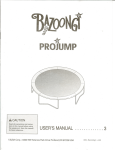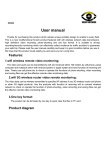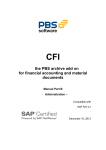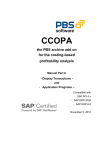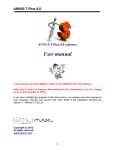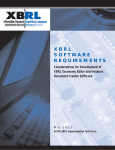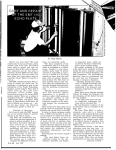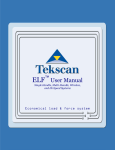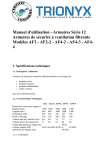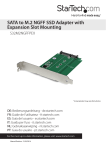Download EMC ViewPoint for SAP Agency Business Module
Transcript
EMC ViewPoint for SAP Agency Business Module Version 2.0 ADMINISTRATION MANUAL P/N 300-003-410 REV A01 EMC Corporation Corporate Headquarters: Hopkinton, MA 01748-9103 1-508-435-1000 www.EMC.com Copyright © 2006 EMC Corporation. All rights reserved. Published February, 2006 EMC believes the information in this publication is accurate as of its publication date. The information is subject to change without notice. THE INFORMATION IN THIS PUBLICATION IS PROVIDED “AS IS.” EMC CORPORATION MAKES NO REPRESENTATIONS OR WARRANTIES OF ANY KIND WITH RESPECT TO THE INFORMATION IN THIS PUBLICATION, AND SPECIFICALLY DISCLAIMS IMPLIED WARRANTIES OF MERCHANTABILITY OR FITNESS FOR A PARTICULAR PURPOSE. Use, copying, and distribution of any EMC software described in this publication requires an applicable software license. For the most up-to-date listing of EMC product names, see EMC Corporation Trademarks on EMC.com. All other trademarks used herein are the property of their respective owners. ii EMC ViewPoint for SAP CAB Module Administration Manual Contents Preface ............................................................................................................................. v Chapter 1 Introducing ViewPoint for SAP CAB Module Introduction ...................................................................................... 1-2 ViewPoint Agency Business Module (CAB) ................................ 1-3 Basics of CAB ............................................................................ 1-3 General customizing of transaction SARA .................................. 1-4 Chapter 2 CAB Module Setup Settlement requests.......................................................................... 2-2 Index generation program /PBS/CAB_WZR_LOAD................ 2-4 Select manually ......................................................................... 2-5 Select automatically.................................................................. 2-5 Delete old run............................................................................ 2-5 Process all documents from input.......................................... 2-6 Process sequential number interval ....................................... 2-6 Create administration indices ................................................. 2-6 Delete previous run .................................................................. 2-6 Initial index generation process..................................................... 2-7 ABAP/4 runtime error message............................................. 2-8 Activation of the indices ................................................................. 2-9 Use last run ................................................................................ 2-9 Select run manually.................................................................. 2-9 Deactivate main archive ........................................................ 2-10 Further index generation processes ............................................ 2-11 Creation of secondary archives.................................................... 2-13 Transform into secondary archive........................................ 2-13 Activate / deactivate secondary archives ........................... 2-13 EMC ViewPoint for SAP CAB Module Administration Manual iii Contents Remuneration lists......................................................................... 2-14 Archive utilities.............................................................................. 2-15 Disk space requirement ................................................................ 2-16 Use of several application servers............................................... 2-17 Chapter 3 Display Transactions User exit - modification................................................................... 3-2 Additional data display .................................................................. 3-3 Chapter 4 Printing CAB Module Documents Introduction ...................................................................................... 4-2 ViewPoint print programs.............................................................. 4-3 Customer specific print programs................................................. 4-4 Chapter 5 Data Export Introduction ...................................................................................... Data Format............................................................................... Safety .......................................................................................... Description data access ................................................................... Description of selection interface ........................................... Size of export file ...................................................................... Transfer of files into PC environment.................................... Further processing in PC analysis programs........................ Recommendations for data export......................................... iv EMC ViewPoint for SAP CAB Module Administration Manual 5-2 5-3 5-4 5-5 5-5 5-7 5-7 5-7 5-8 Preface As part of an effort to improve and enhance the performance and capabilities of its product line, EMC from time to time releases revisions of its hardware and software. Therefore, some functions described in this manual may not be supported by all revisions of the software or hardware currently in use. For the most up-to-date information on product features, refer to your product release notes. If a product does not function properly or does not function as described in this manual, please contact your EMC representative. ViewPoint Functionality Audience This document describes how to administer the various components that make up EMC ViewPoint for SAP Agency Business (CAB) Module. EMC’s technology allows you to effectively manage your application data by providing the ability to define the access, retention, and service level requirements for any business transaction at each point in its lifecycle. This guide is part of the ViewPoint documentation set, and is intended for use by anyone administering the ViewPoint for SAP CAB Module. It is assumed that the installer has a working knowledge of SAP Basis, and has the appropriate levels of responsibilities to perform the tasks described. EMC ViewPoint for SAP CAB Module Administration Manual v Preface Related Documentation Be sure to review the EMC ViewPoint for SAP Release Notes for the most up-to-date information on product features. The following list of related documents are available on the EMC ViewPoint for SAP Documentation CD that was delivered with your EMC ViewPoint SAP software CD. Both the release notes and documentation CD can be found at: http://Powerlink.EMC.com Introductory V EMC ViewPoint for SAP Documentation CD V EMC ViewPoint for SAP Release Notes Installation V EMC ViewPoint for SAP Modules Installation Manual V EMC ViewPoint for SAP Analyzer Plus Installation and User Manual V EMC ViewPoint for SAP BW Analyzer Installation Manual V EMC ViewPoint for SAP Construction and Maintenance Installation Manual V EMC ViewPoint for SAP Fiscal Year Reporter Module Installation and User Manual Miscellaneous V EMC ViewPoint for SAP Material Master Data, Batches, Special Stocks, and BOMs Module Modification Manual Administrative V EMC ViewPoint for SAP Controlling Line Items Module Administration Manual V EMC ViewPoint for SAP Financial Accounting and Material Documents Module Administration Manual V EMC ViewPoint for SAP Purchasing Module Administration Manual V EMC ViewPoint for SAP Sales and Distribution Module Administration Manual V EMC ViewPoint for SAP Production Orders Module Administration Manual V EMC ViewPoint for SAP Agency Business Module Administration Manual V EMC ViewPoint for SAP Construction and Maintenance Module Administration Manual vi EMC ViewPoint for SAP CAB Module Administration Manual Preface V EMC ViewPoint for SAP Costing-Based Profitability Analysis Module Administration Manual V EMC ViewPoint for SAP Master Data Changes Module Administration Manual V EMC ViewPoint for SAP Data Retention Tool Module Administration Manual V EMC ViewPoint for SAP Contract Account Documents Module Administration Manual V EMC ViewPoint for SAP HR Archiving Objects Module Administration Manual V EMC ViewPoint for SAP Material Ledger Documents Module Administration Manual V EMC ViewPoint for SAP Material Master Data, Batches, Special Stocks, and BOMs Module Administration Manual V EMC ViewPoint for SAP Controlling Orders Module Administration Manual V EMC ViewPoint for SAP Profit Center Line Items Module Administration Manual V EMC ViewPoint for SAP Plant Maintenance Module Administration Manual V EMC ViewPoint for SAP Production Orders Module Administration Manual V EMC ViewPoint for SAP Process Orders Module Administration Manual V EMC ViewPoint for SAP Project Systems Module Administration Manual V EMC ViewPoint for SAP Line Items Module Administration Manual V EMC ViewPoint for SAP Special Ledger Module Administration Manual V EMC ViewPoint for SAP Warehouse Management Module Administration Manual V EMC ViewPoint for SAP Custom Module Administration Manual User V EMC ViewPoint for SAP Analyzer Plus Installation and User Manual V EMC ViewPoint for SAP Analyzer Lite Installation and User Manual EMC ViewPoint for SAP CAB Module Administration Manual vii Preface V EMC ViewPoint for SAP Analyzer BW User Manual V EMC ViewPoint for SAP Controlling Line Items Module User Manual V EMC ViewPoint for SAP Financial Accounting and Material Documents Module User Manual V EMC ViewPoint for SAP Purchasing Module User Manual V EMC ViewPoint for SAP Sales and Distribution Module User Manual V EMC ViewPoint for SAP Production Orders Module User Manual V EMC ViewPoint for SAP Modules Utilities User Manual V EMC ViewPoint for SAP Agency Business Module User Manual V EMC ViewPoint for SAP Construction and Maintenance Module User Manual V EMC ViewPoint for SAP Costing-Based Profitability Analysis Module User Manual V EMC ViewPoint for SAP Master Data Changes Module User Manual V EMC ViewPoint for SAP Contract Account Documents Module User Manual V EMC ViewPoint for SAP HR Archiving Objects Module User Manual V EMC ViewPoint for SAP Material Ledger Documents Module User Manual V EMC ViewPoint for SAP Material Master Data, Batches, Special Stocks, and BOMs Module User Manual V EMC ViewPoint for SAP Controlling Orders Module User Manual V EMC ViewPoint for SAP Profit Center Line Items Module User Manual V EMC ViewPoint for SAP Plant Maintenance Module User Manual V EMC ViewPoint for SAP Production Orders Module User Manual V EMC ViewPoint for SAP Process Orders Module User Manual V EMC ViewPoint for SAP Project Systems Module User Manual V EMC ViewPoint for SAP Special Ledger Module User Manual V EMC ViewPoint for SAP Export Interface for Special Ledger Data User Manual V EMC ViewPoint for SAP Warehouse Management Module User Manual viii EMC ViewPoint for SAP CAB Module Administration Manual Preface V EMC ViewPoint for SAP Fiscal Year Reporter Module Installation and User Manual Conventions Used in This Guide EMC uses the following conventions for notes, cautions, warnings, and danger notices. Note: A note presents information that is important, but not hazard-related. ! CAUTION A caution contains information essential to avoid data loss or damage to the system or equipment. The caution may apply to hardware or software. WARNING A warning contains information essential to avoid a hazard that can cause severe personal injury, death, or substantial property damage if you ignore the warning. DANGER A danger notice contains information essential to avoid a hazard that will cause severe personal injury, death, or substantial property damage if you ignore the message. Typographical Conventions EMC uses the following type style conventions in this guide: bold • User actions (what the user clicks, presses, or selects) • Interface elements (button names, dialog box names) • Names of keys, commands, programs, scripts, applications, utilities, processes, notifications, system calls, services, applications, and utilities in text italic • Book titles • New terms in text • Emphasis in text Courier • • • • • • Prompts System output Filenames Pathnames URLs Syntax when shown in command line or other examples EMC ViewPoint for SAP CAB Module Administration Manual ix Preface Where to Get Help Courier, bold • User entry • Options in command-line syntax Courier italic • Arguments in examples of command-line syntax • Variables in examples of screen or file output • Variables in pathnames <> Angle brackets for parameter values (variables) supplied by user. [] Square brackets for optional values. | Vertical bar symbol for alternate selections. The bar means or. ... Ellipsis for nonessential information omitted from the example. EMC support, product, and licensing information can be obtained as follows. Product information — For documentation, release notes, software updates, or for information about EMC products, licensing, and service, go to the EMC Powerlink website (registration required) at: http://Powerlink.EMC.com Technical support — For technical support, go to EMC WebSupport on Powerlink. To open a case on EMC WebSupport, you must be a WebSupport customer. Information about your site configuration and the circumstances under which the problem occurred is required. Your Comments Your suggestions will help us continue to improve the accuracy, organization, and overall quality of the user publications. Please send your opinion of this guide to: [email protected] x EMC ViewPoint for SAP CAB Module Administration Manual 1 Invisible Body Tag Introducing ViewPoint for SAP CAB Module This chapter includes these topics: V Introduction ........................................................................................1-2 V ViewPoint Agency Business Module (CAB) ..................................1-3 V General customizing of transaction SARA.....................................1-4 Introducing ViewPoint for SAP CAB Module 1-1 Introducing ViewPoint for SAP CAB Module Introduction The ViewPoint modules are constructed in modular form and cover the application modules FI, SD, MM, CO etc. with a special program package for exactly this application. You can easily see from the name which ViewPoint module belongs to which SAP module: FI, SD, MM, CO etc. All ViewPoint modules have in common that they can be easily installed in the SAP R/3 system via the SAP transport utilities "tp" and "SAINT". Installation details of the ViewPoint modules are in the EMC ViewPoint for SAP Modules Installation Manual. This administration manual was written to make construction and administration of the ViewPoint CAB Module as easy as possible. At first, data archiving with transaction SARA is discussed; the second topic is the ViewPoint index construction from the SAP archive files. The EMC ViewPoint for SAP Modules Utilities User Manual contains additional module information. 1-2 EMC ViewPoint for SAP CAB Module Administration Manual Introducing ViewPoint for SAP CAB Module ViewPoint Agency Business Module (CAB) A global menu for all products and utilities of the ViewPoint CAB Module and a menu especially for the ViewPoint CAB Module are shipped with the ViewPoint CAB Module. The global menu is started via the area menu /PBS/PBS, which you can include in your role. It is possible to access the area menu /PBS/CAB via the area menu /PBS/PBS, which is included in your respective activity group. Another possibility involves just including the area menu /PBS/CAB in your role. All programs described in this manual are included in the menu. Basics of CAB The administrative task of the ViewPoint CAB Module consists of setting up and activating the ViewPoint archive, and analyzing the archive with the tools provided in the event of any problems occurring. Prerequisites for the setup and use of the ViewPoint CAB Module include successful archiving performed with SAP means and access to the archive file that is consequently created. From 4.0B, this access can also be realized via and optical archiving system, using Archive Link. In this case, the status of the archive file must be Accessible. The ViewPoint CAB Module uses archiving runs of the archiving objects: V WZR — Settlement requests V WRECH — Remuneration lists The SAP archiving program is executed using transaction SARA. A description of standard archiving is not part of this manual. ViewPoint Agency Business Module (CAB) 1-3 Introducing ViewPoint for SAP CAB Module General customizing of transaction SARA Figure 1-1, “General technical settings for transaction SARA,” is displayed after selecting Customizing > Technical Settings. Figure 1-1 General technical settings for transaction SARA The checkbox Time of verification > Read should be deactivated here. If this is not the case, the archive is read sequentially during each individual document access. 1-4 EMC ViewPoint for SAP CAB Module Administration Manual 2 Invisible Body Tag CAB Module Setup This chapter includes these topics: V V V V V V V V V V Settlement requests ............................................................................2-2 Index generation program /PBS/CAB_WZR_LOAD..................2-4 Initial index generation process .......................................................2-7 Activation of the indices ...................................................................2-9 Further index generation processes .............................................. 2-11 Creation of secondary archives ......................................................2-13 Remuneration lists ...........................................................................2-14 Archive utilities ................................................................................2-15 Disk space requirement...................................................................2-16 Use of several application servers .................................................2-17 CAB Module Setup 2-1 CAB Module Setup Settlement requests In order to archive settlement requests, the SAP archiving tool is first used to remove the data from the R/3 database. The tool is called up using transaction SARA. The archiving is object-oriented and WZR is the archiving object for the settlement requests. The archived data is written to sequential files outside the database by the SAP archiving program. The reorganized data can no longer be loaded back into the database and can only be evaluated sequentially. The reduced load on the R/3 database can be measured using the ViewPoint Database Analyzer Plus. The generated SAP archives are written to the ViewPoint CAB Module with the ViewPoint index generation program /PBS/CAB_WZR_LOAD. The index generation program reads the SAP archive files and generates various secondary indices that are saved in SAP’s own ADK format. The physical directory, or the files respectively, in which this data is located result from the logical path that was assigned to the archiving object /PBS/WZR using transaction AOBJ. The archiving object is shipped with the logical standard path ARCHIVE_DATA_FILE, which is also used for the initial archiving object WZR. However, we recommend that a separate logical path is defined within the scope of archive object customizing for ViewPoint archiving objects. After the secondary indices have been constructed successfully, the archived settlement requests are available for online processing and can be evaluated easily using the ViewPoint transactions. The functionality of the ViewPoint transactions corresponds to that of the SAP transactions, but they are able to read and display both data that is resident in the R/3 database as well as archived data from the ViewPoint module. Since the data that is located in the ViewPoint module can no longer be changed, a regular data backup of the archive is not necessary. The SAP archive file that is generated during the next reorganization of the database can be added to the existing ViewPoint module using the index generation program /PBS/CAB_WZR_LOAD. 2-2 EMC ViewPoint for SAP CAB Module Administration Manual CAB Module Setup The index generation program can be started from the main menu /PBS/PBS or the menu /PBS/CAB, as shown in Figure 2-1, “Calling index generation program for archived R/3 settlement requests.” Figure 2-1 Calling index generation program for archived R/3 settlement requests Settlement requests 2-3 CAB Module Setup Index generation program /PBS/CAB_WZR_LOAD The ViewPoint CAB Module provides the opportunity to keep settlement requests from R/3 available online. For this, you construct the index generation program /PBS/CAB_WZR_LOAD from the SAP archive files of the ViewPoint CAB Module. The selection screen of the index generation program /PBS/CAB_WZR_LOAD with its delimitations is illustrated in Figure 2-2, “Selection screen for index generation program /PBS/CAB_WZR_LOAD.” Figure 2-2 Selection screen for index generation program /PBS/CAB_WZR_LOAD In the next section, the delimitations and their effects during index generation of the settlement requests in the ViewPoint CAB Module are explained. 2-4 EMC ViewPoint for SAP CAB Module Administration Manual CAB Module Setup Select manually Figure 2-3 If the select button Select manually is active, a window is opened when the request screen is confirmed. This window displays a list of available SAP archives that were created on or after the data that was entered, as shown in Figure 2-3, “Proposal list for SAP WZR archives for settlement requests loaded into ViewPoint CAB Module.” Proposal list for SAP WZR archives for settlement requests loaded into ViewPoint CAB Module Now select ( ) those archives that you want to load into your ViewPoint CAB Module. Select automatically In the automatic mode, all SAP settlement request archives that were created on or after the data that was entered are selected without the list being displayed. Archives from this time period that have already been loaded into the ViewPoint module are not selected when doing this. In addition, it is possible to limit the maximum number of physical files. This is necessary if not all selected files can be processed in one run. The program processes the number of files that you have specified in one run and then generates as many runs as required until all files have been processed. Delete old run The parameter Delete old run enables you to remove complete generation runs from the ViewPoint CAB Module. When you press Run, an overview of the runs carried out until now is displayed, from Index generation program /PBS/CAB_WZR_LOAD 2-5 CAB Module Setup which you can select the run to be deleted, as shown in Figure 2-4, “Overview of already executed runs.” Figure 2-4 2-6 Overview of already executed runs Process all documents from input If this radio button is active, the selected SAP archives are completely loaded into the ViewPoint module. An internal safety mechanism prevents the same SAP archive from being loaded several times. Process sequential number interval In the case of very large SAP archives, it may be sensible to split the generation run into several smaller portions. In this case, the radio button Sequential processing must be activated and the corresponding interval limits must be defined. Create administration indices If this parameter is set, the administration table /PBS/CAB_FILE is updated after the actual generation process has been completed. If you want to carry out several generation runs, one after another, this parameter should not be set until the last run is carried out. Is this parameter was not set or if the entries in the administration table /PBS/CAB_FILE were damaged, you can construct the administration indices at any time separately using the report /PBS/CAB_FILE or the menu path Archive > Activate index. Delete previous run If this parameter is set, the data from the previous run is automatically deleted after the actual generation run has been completed successfully. In the implementation phase it can often make sense to not set this parameter and to keep the previous run as a backup. Older runs can then also be deleted separately later on using the report /PBS/CAB_WZR_DEL or via the menu path Archive > Delete index. EMC ViewPoint for SAP CAB Module Administration Manual CAB Module Setup Initial index generation process If all necessary information has been entered in the selection screen of the load report /PBS/CAB_WZR_LOAD, the selection screen can be saved as a selection variant for the initial construction of the ViewPoint module and the report can be started as a background process. Note: The ViewPoint CAB Module must be constructed per client. After the CAB archive has been generated successfully, archive selection statistics are displayed by the program /PBS/CAB_WZR_LOAD, as shown in Figure 2-5, “Selections statistics for report /PBS/CAB_WZR_LOAD.” Figure 2-5 Selections statistics for report /PBS/CAB_WZR_LOAD Initial index generation process 2-7 CAB Module Setup ABAP/4 runtime error message If the generation process terminates with one of the following ABAP/4 runtime error messages: V SYSTEM_NO_MORE_PAGING V EXTRACT_NO_MORE_PAGING This is due to the insufficient size of the SAP paging file. Solution 1. Using transaction SM04, Goto > Memory, an overview of the usage of the roll and paging memory by the active users and their transactions is displayed. Try to use this to clarify whether it is perhaps not the current program, but one of the others that requires so much memory. Transaction ST02 also shows the memory utilization. 2. Use transaction RZ10 or ST02 in the current instance profile to check both the parameters ’rdisp/ROLL_MAXFS’ and ’rdisp/PG_MAXFS’. The values that can be found there specify the current block sizes for the roll or page area respectively (1=block = 8 kilobytes, 1 kilobyte = 1024 bytes). 3. On the system page, compare the size of the joint partition for the roll and paging area with the values from transaction DB11. If the converted values do not reach the size of the partition, the parameters ’rdisp/ROLL_MAXFS’ and ’rdisp/PG_MAXFS’ must be adapted to the value of the partition that is provided. 4. Restart your R/3 system. If the parameter was changed, the run should be repeated after the data backup of the ViewPoint module has been reloaded again. We also refer you to SAP note number 14779, which provides further information on the error described above. 2-8 EMC ViewPoint for SAP CAB Module Administration Manual CAB Module Setup Activation of the indices If during the generation of the indices the check box "Create administration indices" was not active, they can be created at any time separately using report /PBS/CAB_FILE or the menu path "Archive Ò Activate index," as shown in Figure 2-6, “Selection screen for creation of administration indices.” Figure 2-6 Selection screen for creation of administration indices Use last run If this radio button is active, the last run is automatically used for the creation of the indices. Select run manually Especially in the introductory and test phase it can be useful not to delete older index generation runs but instead to keep them for a while. You can activate an earlier run and construct the corresponding administration indices at any time with the parameter Select run manually. Activation of the indices 2-9 CAB Module Setup Figure 2-7, “Selection list for construction of administration indices for chosen generation run,” shows a selection list as displayed after starting in manual mode. Figure 2-7 Selection list for construction of administration indices for chosen generation run After the construction of the administration indices a protocol is displayed, as shown in Figure 2-8, “Protocol for construction of administration table.” Figure 2-8 Deactivate main archive 2-10 Protocol for construction of administration table This parameter enables you to delete the current indices without having to activate the indices for another generation run at the same time. EMC ViewPoint for SAP CAB Module Administration Manual CAB Module Setup Further index generation processes With the first generation run a ViewPoint index file was created, as described in “Initial index generation process” on page 2-7. If you want to load additional archive data to the already existing ViewPoint index file, this procedure is carried out in a similar way to what was described previously, using a merge run. When importing further SAP archive files, you have to mark those that are to be merged with the existing ViewPoint index file in the selection screen of the report /PBS/CAB_WZR_LOAD, as shown in Figure 2-9, ”Selection statistics for report /PBS/CAB_WZR_LOAD after merge run,” on page 2-12) in the delimitation 'Select archives' and Figure 2-10, ”Selection list for activation of secondary archive,” on page 2-13. If an SAP archive file has already been uploaded into the index archive in a previous run, this is recognized by the report and a warning message is displayed. It is not possible that identical data records are referenced more than once in the index archive. The load program /PBS/CAB_WZR_LOAD should be started again as a batch process. A new ViewPoint index file is constructed from the existing index archive and the access. Archives from earlier runs are automatically deleted if the checkbox "Delete previous run" is checked. The files from earlier runs can also be deleted separately later on via the menu option "Delete index" in the ViewPoint CAB Module. If all further load processes are completed, use the report /PBS/CAB_FILE as already described in chapter 3.1.4, to load the administration table /PBS/CAB_FILE into the SAP R/3 system. This step is not necessary if you selected the option "Create administration indices" when executing the last run. Further index generation processes 2-11 CAB Module Setup Figure 2-9, “Selection statistics for report /PBS/CAB_WZR_LOAD after merge run,”shows typical selection statistics after a merge run. Figure 2-9 2-12 Selection statistics for report /PBS/CAB_WZR_LOAD after merge run EMC ViewPoint for SAP CAB Module Administration Manual CAB Module Setup Creation of secondary archives The run time of the load program often increases to an unbearable level (e.g. more than 10 hours) with an increasing number of profit center line items in the CAB archive. To avoid such run times it is possible to transform the currently active CAB (main) Archive with the help of the program /PBS/CAB_FILE, as describe in “Activation of the indices” on page 2-9, into a secondary archive and to start with the creation of a new main archive during the next load run. The current main archive and all active secondary archives are always considered during the read accesses. As the CAB archives are stored in ADK format, you have the possibility to move older secondary archives, which are accessed less frequently, into an optical archive. Transform into secondary archive If you set this parameter, the current main archive will be deactivated and simultaneously activated as a secondary archive. Activate / deactivate secondary archives These two parameters enable you to activate or deactivate CAB archives that have been converted into secondary archives. An overview of all available archives is displayed if you press the button "Selection list". To do this, archives that can be activated or deactivated are to be selected by clicking on the corresponding checkbox, as shown in Figure 2-10, “Selection list for activation of secondary archive.” Figure 2-10 Selection list for activation of secondary archive Creation of secondary archives 2-13 CAB Module Setup Remuneration lists The procedure for remuneration lists logically corresponds to the process for settlement requests, as described in “Creation of secondary archives” on page 2-13. The SAP archiving object for remuneration lists is called 'WRECH'. The index data is managed via the archiving object '/PBS/WRECH'. 2-14 EMC ViewPoint for SAP CAB Module Administration Manual CAB Module Setup Archive utilities The following ABAP/4 reports are available for testing the ViewPoint CAB Module: V Report /PBS/CAB_WZR_SCAN V Report /PBS/CAB_WRECH_SCAN These reports provide a technical view of the ViewPoint CAB Module. In particular, it is possible to view the statistics of the current as well as all previous ViewPoint index generation runs. V Report /PBS/CAB_WZR_DEL V Report /PBS/CAB_WRECH_DEL These reports enable you to delete one or more ViewPoint index generation runs. Archive utilities 2-15 CAB Module Setup Disk space requirement The ViewPoint CAB Module for the agency business is constructed in database-independent file systems. The system administrator’s task is to reserve free storage capacity in order to construct the archive. A file path that can be used by the ViewPoint index programs should be created for the reserved memory space. In addition, it would be sensible to restrict the read/write authorizations for this file path, which is only valid for the supplied ViewPoint programs. The disk space capacity that is to be made available depends on the number of documents that are to be stored in the archive. You have to assume an occupancy of about 250 bytes per document (including secondary indices). 2-16 EMC ViewPoint for SAP CAB Module Administration Manual CAB Module Setup Use of several application servers In the case of larger R/3 systems, the database and the R/3 applications normally run on different servers known as the database and application server. It is often recommended to use several application servers for performance reasons. However, as the index files of the ViewPoint CAB Module are constructed in database-independent files systems, all application servers must have direct access to these file systems. It is the system administrator’s responsibility to organize the application servers in such a way that the file systems of the ViewPoint module can always be reached with the same path. In UNIX, NFS (Network File System) offers a practical solution. The example below of a three-level R/3 client/server architecture shows how this can be done. The system should be composed of both a database server and an application server (and several presentation servers), the ViewPoint module being created on the database server. In this case, proceed as follows: The file systems containing the ViewPoint module must first be released on the database server using the command share. For example, the following command (syntax of Sun/Solaris) releases the file system /pbs/cab: share -F nfs /pbs/cab . The release file systems can then be mounted on the file system of the application server. A prerequisite for this is that the directories used as mount point exist. The following example of a command mounts the released file system /pbs/cab of the database server sun20 at the mount point /archiv/cab: mount -F nfs sun20:/pbs/CAB /archiv/cab . Please note that in the case of several application servers, the same mount point is to be used for each of them, as only one single path can be assigned (in this case, for example, /archiv/cab). Note: The server containing the data of the ViewPoint module must also be an NFS server so that the application servers can access the NFS server as NFS clients. Under Windows NT - if NFS was not installed here - the local drive of the database server on which the ViewPoint module is contained must be shared. This can be done in the menu "Sharing" in the properties of the respective drive. After the drive has been shared, the Use of several application servers 2-17 CAB Module Setup application server can be connected to the network drive, for example, by using the Explorer (Tools ’ Map Network Drive). 2-18 EMC ViewPoint for SAP CAB Module Administration Manual 3 Invisible Body Tag Display Transactions This chapter includes these topics: V User exit - modification.....................................................................3-2 V Additional data display ....................................................................3-3 Display Transactions 3-1 Display Transactions User exit - modification In the function group ’V61A’ there are the includes ’RV61AFZA’ and ’RV61AFZB’ in which various forms are defined as user exits. If you have entered modifications here, these must also be copied to the includes ’/PBS/RV61AFZA’ and ’/PBS/RV61AFZB’. The includes are assigned to the function group ’/PBS/CAB_V61A’. 3-2 EMC ViewPoint for SAP CAB Module Administration Manual Display Transactions Additional data display In the transaction ’/PBS/WZR3 ’ can be indicated similarly to the transaction ’ WZR3 to ’ complementary data. The respective Dynpros must in the function group ’ XLFX ’ (Agency Business: User exit 1) to be put on. Over the function group ’ WLF2 ’ are filled the complementary data fields. Thus this also over the function group ’/PBS/WLF2 ’ functions, must you with the transaction ’ SMOD ’ the SA by far object ’/PBS/WZR ’ activate. The complementary data announcement is also the activation of the SA by far object ’ LWZRE011 ’. Additional data display 3-3 Display Transactions 3-4 EMC ViewPoint for SAP CAB Module Administration Manual 4 Invisible Body Tag Printing CAB Module Documents This chapter includes these topics: V Introduction ........................................................................................4-2 V ViewPoint print programs ................................................................4-3 V Customer specific print programs ...................................................4-4 Printing CAB Module Documents 4-1 Printing CAB Module Documents Introduction The transactions ’/PBS/WLN4’ and ’/PBS/WLN6’ are available for printing documents. In contrast to the original SAP transactions, these print transactions do not perform any updates to the database table NAST (message status). The ViewPoint print transactions should therefore not be used for normal day-to-day printing, and should only be used for archived documents. In order to print settlement documents, which are located in the ViewPoint CAB Module, customer-specific modifications must generally be carried out to the print programs. The necessary steps for doing this are explained in this chapter. 4-2 EMC ViewPoint for SAP CAB Module Administration Manual Printing CAB Module Documents ViewPoint print programs The ViewPoint print programs enable the transfer of data from the ViewPoint CAB Module into a SAPscript form. The SAP standard print programs served as templates for the print programs that were extended to include ViewPoint archive accesses. The ViewPoint print programs listed in Table 4-1, “ViewPoint print programs,” are shipped. Table 4-1 ViewPoint print programs Description Program name Transaction Messages from settlement requests /PBS/RWLFWR04 /PBS/WLN4 Messages from remuneration lists of settlement requests /PBS/RWLFWR06 /PBS/WLN6 Both print programs use the subroutine pool '/PBS/RWLFNAST' copied from 'RWLFNAST' for transferring data to a SAPscript form. ViewPoint print programs 4-3 Printing CAB Module Documents Customer specific print programs If your print programs are based upon customer specific development, they must be extended to include ViewPoint access routines to be able to read data from the ViewPoint CAB Module. Customizing settings regarding the message control (for example, the assignment between print program and SAPscript form) are not necessary. Proceed as follows: 1. Naming the print program First, determine the names of your print programs. To do this, use transaction SE16 to display the table TNAPR. This table is used for message control, by creating an assignment between print program, SAPscript form, and message type. Start transaction SE16 and enter TNAPR as the table. In the following selection screen of the Data Browser, enter the value ’WR’ as the value for the entry field KAPPL. In the hit list, the names of your print programs are displayed in the column PGNAM. It is recommended to copy the print programs that are determined in this way with the ViewPoint name space. This means, for example, that if your current print program is named ’ZRWLFNAST’, you should copy it as ’/PBS/ZRWLFNAST’. The ViewPoint name space guarantees that the assignment between ViewPoint print program and SAPscript form of the original print program is made automatically. 2. Using the ViewPoint print program as a template for the archive access The ViewPoint print program ’/PBS/RWLFNAST’ is a copy of the SAP standard print program ’RWLFNAST’ with specific modifications for the archive access. These changes are indicated with the correction mark "PBSK" and you should copy them into your print programs. Here, SAP function modules are replaced by ViewPoint function modules. 3. Extending print programs to include the archive data access 4-4 EMC ViewPoint for SAP CAB Module Administration Manual Printing CAB Module Documents If your print program works with select statements for getting data that you have additionally included in contrast to the SAP standard print program, then these select commands must also be adapted for the access to the ViewPoint CAB Module. To make this modification easier, ViewPoint developed its own utility: the Conversion Tool. This tool searches for the select commands in an ABAP/4 program and adapts them for the archive accesses using ViewPoint function modules. You can find more information on this in the manual for the Conversion Tool. In addition to the Conversion Tool, you can also find the Archive access tutorial (transaction /PBS/UTIL_ACCESS_ARC) in the ViewPoint Utilities. This tutorial includes a series of module-specific example reports for the archive access via the various indices. Customer specific print programs 4-5 Printing CAB Module Documents 4-6 EMC ViewPoint for SAP CAB Module Administration Manual 5 Invisible Body Tag Data Export This chapter includes these topics: V Introduction ........................................................................................5-2 V Description data access .....................................................................5-5 Data Export 5-1 Data Export Introduction As basis serves the transactions "/PBS/CABR05" and "/PBS/CABV05" that selects the data via logical databases from the SAP system and the ViewPoint archive and exports them directly into a sequential file in the Unix/Windows NT environment. You can define the fields to be exported via the ABAP list viewer (SAP-ALV). The created file can be processed by a PC analysis program after the transfer in the PC environment. The usual SAP standard format AIS (Audit Information System) was selected as data format, as shown in Figure 5-1, “Concept for exporting data.” PBS Archive data R/3Database 3 2 1 PBS-Index Extract reports via logical database Free field selection via ALV Data in SAP-AIS Format sequential data file Transfer to PC in text format PC analysis tool (ex. WinIdea) Figure 5-1 5-2 Concept for exporting data EMC ViewPoint for SAP CAB Module Administration Manual Data Export Data Format The SAP AIS format has the structure listed in Table 5-1, “SAP AIS format structure.” Table 5-1 SAP AIS format structure Line type Number Characteristic value Header 1 Field name 2 Description 3 Field description 4 Data type (C,N,P,I,D,T,F) C = text N = numeric text on the left filled with zero P = packed (number digits = field length * 2 - 1) This is the SAP internal type. The format [-]digits[,|.digits] is used in the data records. Example: Type P length 7 decimal places 2 leads to the output -12345678901.23 I = integer D = date with format DD.MM.YYYY T = time with format HH:MM:SS F = floating point number 5 Field length 6 Number decimal places 7 Currency code or quantity indicator (F,W,M,E) A currency unit field always comes after a currency field. A unit of measure field always comes after a quantity field. F = currency W = currency unit M = quantity E = unit of measure 8 Special field types (R,C,P,M) R = rank (statistics) C = counter (statistics) P = percentage (statistics) M = mean value (statistics) 9 Data records Data line The field delimiter is a TAB (hex code x'09'). Introduction 5-3 Data Export The interface format is agreed between SAP AG and the following suppliers of revision software for external and internal auditors: V A C L Services Ltd., Vancouver BC, Canada http://www.acl.com/en/default.asp V AUDICON GmbH, 70565 Stuttgart http://www.audicon.net/ V (I D E A) http://www.caseware.com/fsh.asp Safety After the export the data leaves the SAP environment. The SAP authorization concept no longer works in the file system of the: V Target computer (c:\...) V Application server (d:\usr\sap\...). Protect the data against unauthorized access. 5-4 EMC ViewPoint for SAP CAB Module Administration Manual Data Export Description data access Description of selection interface In general, the selection screen of the export programs consists of three parts: Part 1 - Delimitations to influence the scope of selection In this part the delimitation possibilities are provided from the logical databases which are assigned to each report. Part 2 - Selection of list layouts A list layout contains all fields that are to be displayed from the selected data volume. The list can be defined via SAP-ALV (ABAP-List-Viewer) within an export program and can be stored under an own name. Several list variants are possible per export program in order to meet different requirements. One list definition each is supplied with the ViewPoint standard, as shown in Figure 5-2, “Selection of list layouts.” Please see the standard documentation for more information about the SAP-ALV functions. Figure 5-2 Selection of list layouts To create a list for an export program, execute first the report in the dialog with the option "Display/Print". When doing this, the data volume to be selected should be kept small. Then you can define the scope of the list via the function keys Options' Layout ' change. The list variant can be stored via Options' Layout ' store. If the list is defined in a test system and should then be transferred into the production system, transfer the layout into a transport request via Options' Layout ' Layout administration ' Layout' Transport. Description data access 5-5 Data Export Note: In general the width of a list is limited due to the number of bytes or number of columns. This means you usually cannot select all fields at the same time in one list definition. Therefore, a field selection has to be made. Part 3 - Output option In general, you can decide in the selection screen, whether the selected dataset should be displayed as ALV list or transferred into the indicated export directory. If there is a large selection volume, the process should be made in the background. During the data export before the execution is made it is checked whether: V The indicated directory exists V It can be written into the indicated directory V The indicated file name already exists. If this is the case, the final user can decide whether the existing file can be overwritten or whether another file name should be chosen, as shown in Figure 5-3, “Output option.” Figure 5-3 Output option At the end of each export transaction an export statistic is exported, as shown in Figure 5-4, “Export log.” Figure 5-4 5-6 Export log EMC ViewPoint for SAP CAB Module Administration Manual Data Export Size of export file The size of an export file depends on the number of items to be selected and the width of the selection list. You will get this information when you display or change a layout. In principle, the disk space can be determined as follows: (number items X line width of the layout) + 2000 bytes header record SAP-AIS The file size of the program is limited to 650 MB to enable the transfer of data on a CD. If the data volume to be selected is larger, subsequent files are created with name extensions Vxxxx (xxxx = sequence number). Transfer of files into PC environment If the creation of the extract stock is completed, the files from the Unix/Windows NT server into the PC environment can be transferred in the ASCII mode (ftp> asc). Further processing in PC analysis programs The extract stocks can be further processed by indicating a file format in the usual analysis programs available, as shown in Figure 5-5, “Definition of file format (e.g., PC program Idea).” Figure 5-5 Definition of file format (e.g., PC program Idea) Description data access 5-7 Data Export With the PC analysis program you have many possibilities to check the extracted data whether they are factually consistent. Recommendations for data export 1. Definition of ALV layouts Different database tables are partly used in one export structure in the export programs. It might occur that fields are displayed several times when defining the list layout, as they are included in each database structure. To distinguish those fields, the technical field names are implemented by a field extension indicator (see table overview export programs). Use the right mouse button and the selection of the function key ’Technical field names’ to switch to the internal name between field name and technical field name. 2. Single line lists for export on PC List of several lines can be created in the layout definition. If one list variant should be used for the data export, only single line lists are permissible. 3. Default value file path You can define a default value in the user master for the file path via the parameter ID ’/PBS/CAB_LIS_PATH’. 4. Termination data export with the message ’Variant was not found’ The layout in which the fields to be extracted were defined does not exist or it was not stored when the layout was created. 5. Termination PC analysis program during import of the SAP stock with the message ’SAP/AIS file is invalid’ During the transfer of the export files from the Unix/Windows NT environment into the PC environment the transfer was executed in the ASCII mode instead of the BINARY mode by error, and/or, under AS400 no ASCII conversion was accomplished. 6. Termination during dialog processing with message MOVE_TO_LIT_NOTALLOWED_NODATA A field variant is used that has more than 1020 bytes or more than 90 columns. Such variants are only allowed for data export and cannot be used in the dialog. 5-8 EMC ViewPoint for SAP CAB Module Administration Manual


















































